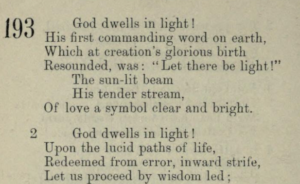Contributor(s): Shared on: 8 November 2021 under the Creative Commons Zero (CC 0) Universal license a Public Domain dedication Categories: Tags: | Contribute a translation | Source (English) |
|---|
|
God dwells in light!
His first commanding word on earth,
Which at creation’s glorious birth
Resounded, was: “Let there be light!”
The sun-lit beam
His tender stream.
Of love a symbol clear and bright. | |
God dwells in light!
Upon the lucid paths of life,
Redeemed from error, inward strife,
Let us proceed by wisdom led;
In happiness
And in distress,
The light of God be on us shed! | |
God dwells in light!
A holy, heav’nly spark in trust
He gave to ev’ry child of dust,
Prepared by Him, th’ Eternal One ;
A brilliant ray
To shine by day,
But not to set when life is gone. | |
God dwells in light!
He broke the sinner’s mighty hand,
And crushed the despot’s haughty band.
In glorious days of olden time;
And ne’er to wane
In Israel’s fane
Rekindled was His light sublime. | |
God dwells in light!
In Him, oh! let us now rejoice,
And raise to him the heart and voice,
Who worketh wonders evermore;
The guiltless tear
With light to cheer,
He changeth not, our God of yore! | |
God dwells in light!
He touched the champions’ pious hearts
With fire, that courage e’er imparts,
For faith above all time and space !
Guard truth and love,
Sent from above
Thou’lt triumph then, God’s priestly race! |
“God dwells in light!,” by Rabbi Moritz Mayer, published in 1856, appears under the subject “Feast of Dedication” (i.e. Ḥanukkah) as Hymn 193 in Hymns Written for the Use of Hebrew Congregations (Penina Moïse et al., Ḳ.Ḳ. Beth Elohim, 1856), pp. 188-189. –Aharon Varady Source(s)
 Ḳahal Ḳadosh Beth Elohim (Hebrew: קהל קדוש בית אלהים, also known as Ḳ.Ḳ. Beth Elohim, or more simply Congregation Beth Elohim), founded in 1749 in Charleston, South Carolina, is one of the oldest Jewish congregations in the United States. The founding members of the synagogue were Jews of Spanish and Portuguese descent (Sepharadim), who arrived into Charleston via London, England. Before 1830 Ḳahal Ḳadosh Beth Elohim was a place of worship for Spanish and Portuguese Jews using Portuguese rituals as done in Portugal before the Spanish and Portuguese inquisitions. A splinter group animated by the European Reform movement, the Reformed Society of Israelites, formed in 1824. While at first this group did not succeed in reforming Beth Elohim, by the mid 1830s Beth Elohim had reabsorbed its members and its ḥazzan, Gustavus Poznanski (1804–1879), joined the Reform camp in 1840. After the first synagogue building was destroyed by fire in 1838, it was rebuilt two years afterward (in a Greek Revival style designed by Cyrus L. Warner) with an organ to the chagrin of the traditionalists. Ḳahal Ḳadosh Beth Elohim is recognized as the oldest Reform Jewish congregation in the Americas.  Rabbi Moritz Mayer (originally Moses Maier, later Maurice Mayer; 1821-1867) born in Dürckheim-on-the-Haardt, Germany, fled to the United States and to New York as a political refugee of the 1848 revolution. In 1859, after seven years as the rabbi of Ḳ.Ḳ. Beth Elohim in Charleston, South Carolina, he returned in poor health to New York where he contributed frequently to the Jewish press, and translated various German works into English: Rabbi Samuel Adler's catechism, Abraham Geiger's lectures on Jewish history, and Ludwig Philipson's pamphlet, Haben die Juden Jesum Gekreuzigt? (the Crucifixion from the Jewish Point of View), et al. In 1866, a number of his English translations of Fanny Neuda's teḥinot in German (from her Stunden Der Andacht, 1855/1858) were published in a volume he titled Hours of Devotion. The work also included a number of his own prayers as well as those of Marcus Heinrich Bresslau. The following year, Moritz Mayer passed away. He was 45 years old.(We are indebted to Anton Hieke for his research on Mayer, " Rabbi Maurice Mayer: German Revolutionary, Charleston Reformer, and Anti-Abolitionist" published in Southern Jewish Life, 17 (2014), pp. 45-89.)For Mayer's translations of prayers by other authors, please visit here. Aharon Varady (M.A.J.Ed./JTSA Davidson) is a volunteer transcriber for the Open Siddur Project. If you find any mistakes in his transcriptions, please let him know. Shgiyot mi yavin; Ministarot naqeni שְׁגִיאוֹת מִי־יָבִין; מִנִּסְתָּרוֹת נַקֵּנִי "Who can know all one's flaws? From hidden errors, correct me" (Psalms 19:13). If you'd like to directly support his work, please consider donating via his Patreon account. (Varady also translates prayers and contributes his own original work besides serving as the primary shammes of the Open Siddur Project and its website, opensiddur.org.) Read a comment / Leave a comment (moderated) Works of related interest: |












Leave a Reply